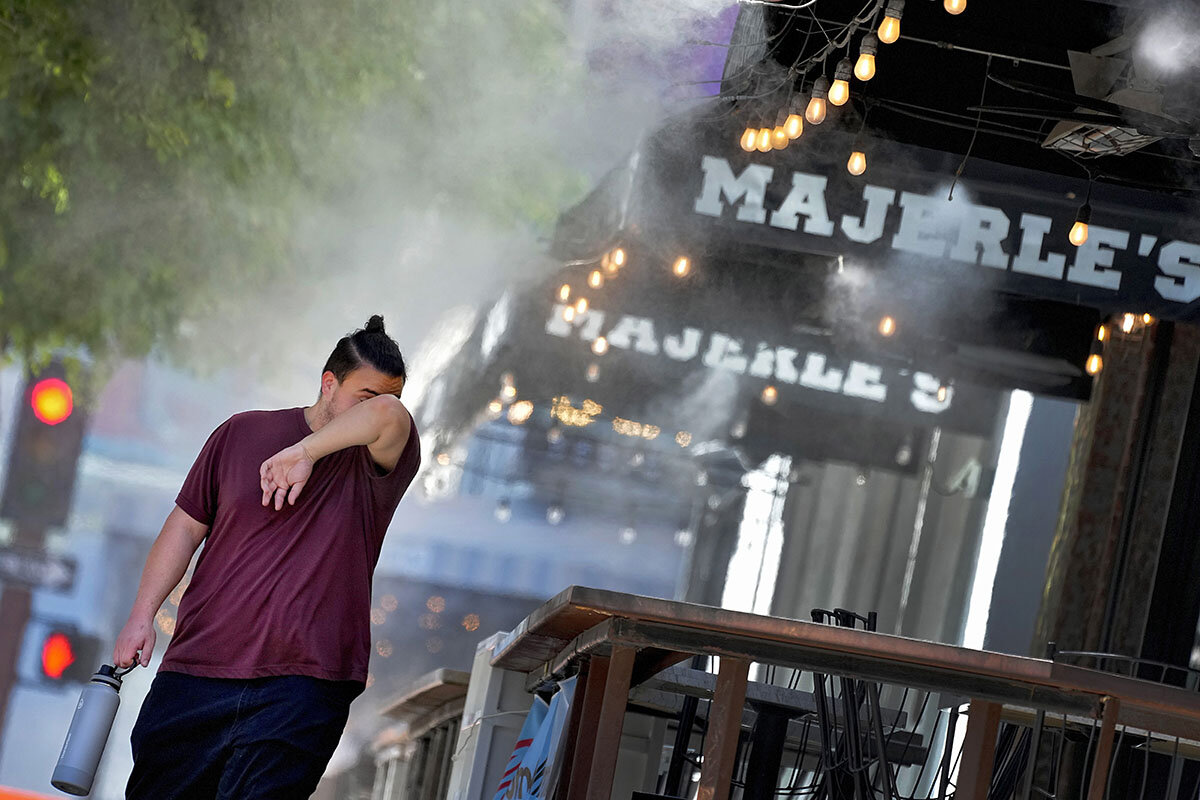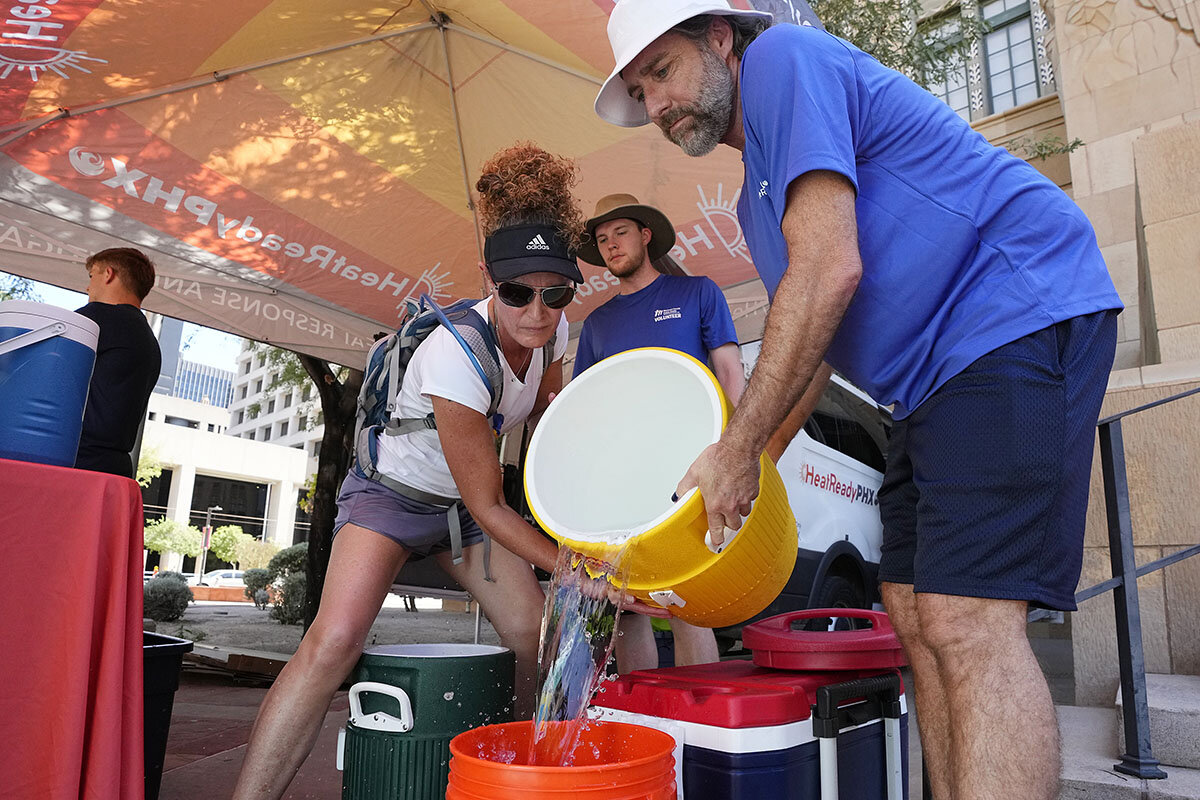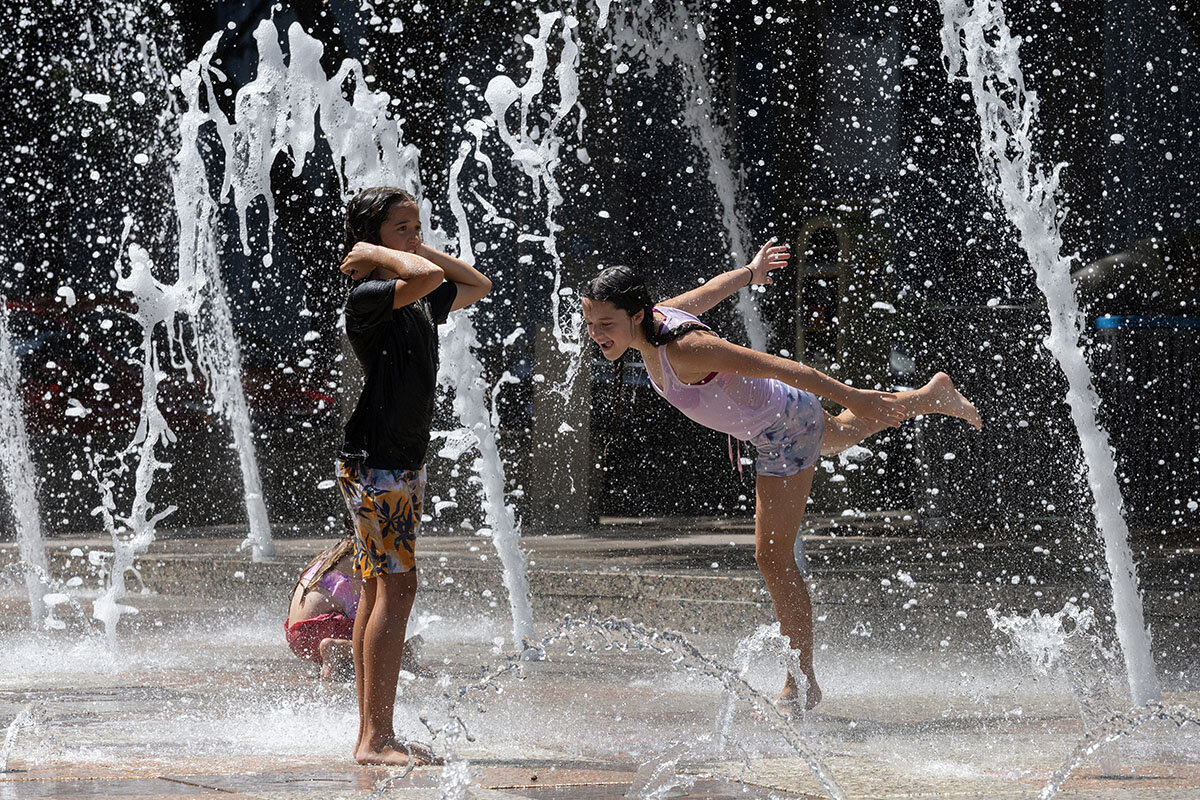From heat czars to tree planting, relief for urban heat islands
Loading...
| Bakersfield, Calif.
For 12 nights in a row, The Mission at Kern County shelter has been filled to capacity. That’s unusual for summer months in Bakersfield, California, where many of the city’s unhoused residents tend to sleep outdoors during the warm nights. But Bakersfield’s warm nights have become unbearably hot.
“People can sleep outside if it’s a summer night, 80 degrees, 78 degrees,” says Carlos Baldovinos, The Mission’s executive director. “But if it gets [as] hot as we’re seeing ... over 100 degrees, people don’t want to be out there because at night it’s hot, too.”
Hot, arid Bakersfield sits in the western margin of a record-breaking heat wave that spreads across the United States. Phoenix is making headlines for its record duration of days over 110 degrees – 29 as of Friday. Las Vegas has been running 4 degrees above seasonal averages lately. Though many cities may see some relief in coming days, the heat wave currently stretches from Texas, in the low 100s, into the rest of the South; heat advisories run throughout the Midwest and along the East Coast, from Virginia through New Hampshire.
Sweltering, unrelenting heat has come to define this summer, with July shaping up to be the hottest month ever recorded for the planet. It’s especially challenging in dense urban areas, where temperatures are exacerbated by concrete pavement, auto emissions, tall heat-retentive buildings, and a lack of greenery offering shade.
These urban heat islands are testing resources put in place over the past few years – Phoenix, Miami, and Los Angeles are leading the way with city heat officers – but across the country, state, regional, and local governments are also bolstering programs and services. President Joe Biden on Thursday announced his own plan to help people deal with heat. In these efforts, leaders have their eye on permanently higher temperatures and the dangers they bring, especially for the country’s most vulnerable people.
“There’s been a shift in awareness of heat at the decision-maker level,” says Ladd Keith, an expert in urban planning and climate change at the University of Arizona who co-wrote a report on how cities can adapt to rising temperatures.
In addition to Phoenix’s heat officer, for instance, government agencies in surrounding Maricopa County coordinate with services on the ground to administer help – and listen. “We have a sustained network now of nonprofit, social service providers, and faith-based organizations that are in touch with many of the most vulnerable in our community and can ensure that we’re providing support to the right people, but also give us feedback on what we should be doing to make sure that we’re providing the right support in the future,” says Dr. Keith.
Chillin’ by the AC vent
Back in Bakersfield, it’s 102 degrees at 6 p.m. when the public water park closes and Sirena Salazar packs up the birthday picnic she’s been enjoying with her children and best friend. “The water park cools us off for a minute,” says Ms. Salazar, who stays in a shelter at night with her three kids, and works full time during the day driving people to medical appointments.
The heat is a constant concern. “I’m coping with the summer,” she says, with a focus on her children’s daily needs.
Coping means visiting pools or tree-shaded parks whenever they can. At night, 12-year-old Karalynn Salazar tries to keep her older siblings from taking her spot on the top bunk, closest to the air-conditioning vent. “So all of them are hot and I’m just over there chillin’ in the AC,” says Karalynn.
Bakersfield is like other cities that have intense heat concentrated at its urban core. Eighty percent of Americans live in urban areas – 41 million of whom live in urban heat islands, where low-income and vulnerable communities also tend to be overrepresented.
Those vulnerable residents have no choice but to endure the heat, says Guangqing Chi, a professor of sociology, demography, and public health at Pennsylvania State University who studied the effects of city planning on urban heat islands. Wealthier residents “may have a seasonal house or may be able to go someplace cooler,” says Dr. Chi. “But these people ... they are kind of stuck where they are.”
A visit to the interactive heat map by the University of California, Los Angeles shows that Bakersfield’s Kern County has an average 126 additional heat-related emergency-room visits on days with extreme heat, which experts point out is responsible for more deaths than any other extreme weather event.
A city responds
The heat map is one of the tools informing Los Angeles’ Climate Emergency Mobilization Office, launched last year to implement equitable solutions to climate-related needs. “Heat has been the silent killer or the silent contributor to excess hospitalizations and excess mortality, and we feel [that’s] preventable,” says Marta Segura, LA’s inaugural chief heat officer and director of the emergency center. Ms. Segura is tasked with coordinating resources across government offices, organizations, and community groups to streamline messages to the public and harness and implement ideas.
As temperatures rise, the emergency center deploys resources where they’re most needed, and connects with residents through websites and apps like Cool Spots LA. The strategy seems to be working: LA added more cooling centers to low-income neighborhoods and saw more than a tenfold increase over 2020 in people using them.
“We have seen more people using our resources,” says Ms. Segura, who adds these resources are diverting health problems. “It’s not easy to leave your home and make the trek to a city facility to stay cool. So we feel those people who come really, really need this.”
Other efforts underscore the city’s comprehensive approach to extreme heat: tree planting programs, subsidies for energy efficiency and air conditioners, and links to funding for grassroots projects that combat or adapt to climate change; plus interactive tools that allow residents to track heat-related issues like air pollution and to see which communities are benefiting from public investment.
These efforts are consistent with a growth in heat resources across the country, which parallel a growing recognition of a climate emergency. But experts agree it’s not enough. “Every city in the world should be planning for heat,” says Dr. Keith, who adds that strategies will look different depending on local risks. “If they’re historically a hot location, they’re going to have to plan for chronic heat. .... If they’re a cooler, temperate location, they may have to focus more on what they do during an extreme heat event that may come suddenly.”
Cities like Boston, New York, and Baltimore don’t have designated heat officers, but manage extreme heat through related offices like emergency services or health departments. Thousands of other municipalities across the country lack plans or resources to address extreme heat events. But the participation of every community is essential if strategies to combat extreme heat are going to be successful, says Dr. Chi from Penn State. “The solution is there,” he says. “We really need the entire society, individuals, communities, all levels of government, different sectors of the economy, and even globally. ... Nobody can say, this has nothing to do with me. Everybody is affected.”
United efforts
California has long been unified on a need to address climate policy. The state Office of Planning and Research was established to develop climate policies and regulations in 1970 – under Republican Gov. Ronald Reagan.
Decades later, this wave of extreme heat should make clear the need for more action to correct long-term climate change and find immediate relief from extreme heat, says the office’s director, Sam Assefa. If people don’t believe the science, they should believe their eyes, he says. “It’s happening right in front of you.”
Today, California agencies have access to unprecedented funding to address extreme heat and other climate issues. The state is in its second year of a $54 billion climate initiative aimed at reducing greenhouse gas emissions and extreme heat, fires, and floods. Add to that billions in federal funding through the bipartisan infrastructure act, and general bipartisan support in the state for prioritizing climate action.
The funding, science, and known solutions combine for a historic moment, says Mr. Assefa, who notes the considerable state and federal resources flowing toward climate and infrastructure. “The challenge is, how do we deploy those resources in the most effective ways to significantly minimize the impact in some cases and in certain areas reverse the trend” of global warming, he says.
Under Mr. Assefa’s purview, a new Extreme Heat and Community Resilience Program supports on-the-ground initiatives through targeted grants. Unincorporated communities in the Eastern Coachella Valley, for instance, received more than $644,000 to develop a plan for adding shade to low-income, Spanish-speaking neighborhoods where temperatures can exceed 120 degrees. Other cities like Stockton, San Fernando, and Lake Elsinore received hundreds of thousands of dollars each to create or update local climate adaptation plans.
Dealing with extreme heat is going to require city planners to channel their efforts in new directions, and especially in places that need them most, says Dr. Keith. “It will require new ways of planning our cities, new ways of operating our government, new ways of living our lives.”










